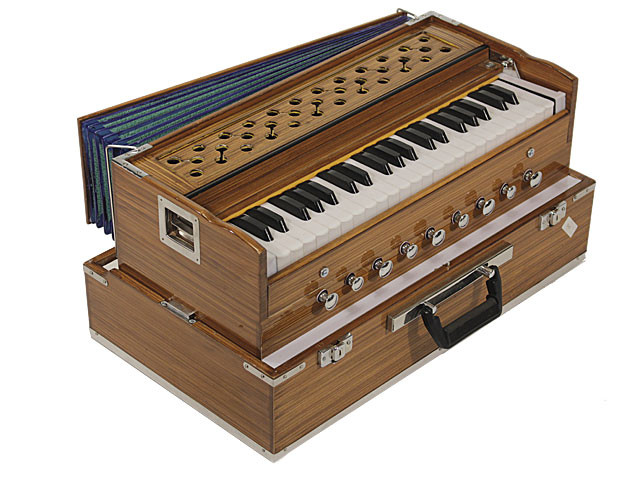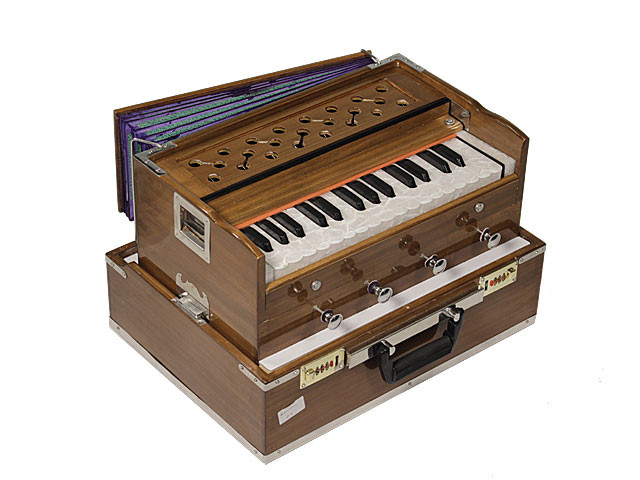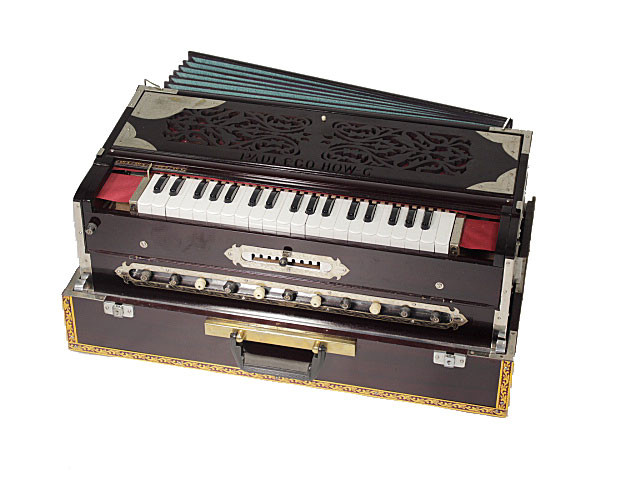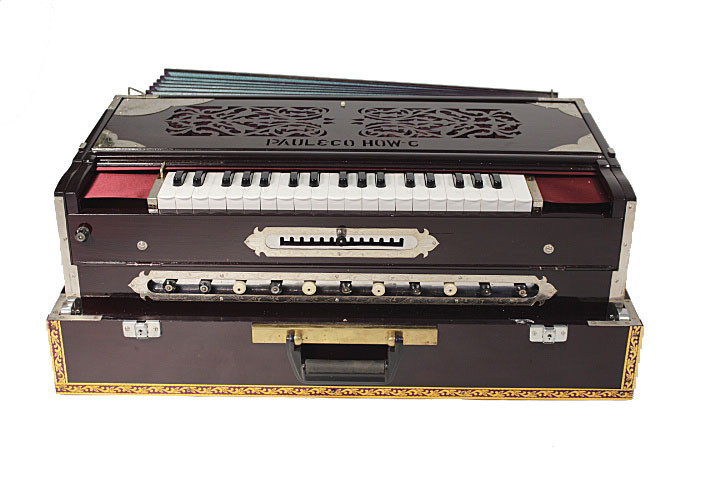- Home
- Guide to Buying a Harmonium
Guide to Buying a Harmonium
How to Choose a Harmonium :
A lot of people dont know what a harmonium should sound like out of the box. We have put together a simple video to explain this. Please watch it even if you haven’t bought the harmonium from us. (supply link here) I understand our website can be more expensive than the other marketplaces. We have our overheads and the vendors in India don’t. We could have done this same business of shipping of harmoniums from India. We did not do this because instruments need setup.
Please see below to see harmoniums broken down by budget.
1) Under $400 harmoniums
Most harmoniums in this price range will be problematic and end up disappointing you.
Cheap harmoniums. We have been in the business for almost 50 years. We could have sold harmoniums in this price range but choose not to. You will often find cheap harmoniums in large internet marketplaces. Often the sellers don’t know about harmoniums and neither check nor prep them. We get calls almost every dayfrom people to get such harmoniums fixed.
2) $400 - $700 harmoniums
Perfect for most people. The most popular harmoniums are in this price range.
These are perfect for learning, concert use and recording use. The materials used in these harmoniums are just right for about any music you want to play on harmoniums: Kirtan, Bhajan, Indian Classical etc.
The construction is mostly pine wood. We have made harmoniums ourselves and they have turned out to be winners in this segment. We call them the MM harmoniums. (MM stands for Musician’s Mall - our store name).
3) $700 - $1200 harmoniums
Premium 2 reed or three reed harmoniums.
These are boutique harmoniums. The makers in this price range use teak wood to make their harmoniums. They use better quality reeds in the instruments. The finish is superior and they can offer 2 or 3 reed configurations. These are not scale change harmoniums. If you find a scale change harmonium in this price, please hope that it works. If it does, kudos, you have a great harmonium for its price. If it doesn't, be ready to spend money to fix it regularly. This may spoil your musical journey. Mainly the brands available in this price range are Bina Music Centre (aka BB), MKS, Paloma and a few more.
4) $1200 onwards
Creme de la Creme harmoniums. Including all the bells and whistles
These harmoniums are usually large in size and mainly scale change harmoniums. If you are looking for the best sounding harmonium these are the right harmoniums. These harmoniums are also heavy and we prefer people do not travel much with them. They are perfect for use at home and studio use.
Most harmoniums are 2 reed harmoniums. There are 3 reed and 4 reed versions too. We haven’t seen a single reed harmonium.
We have created a wonderful video explaining 7 ways to check whether a harmonium has issues or works perfectly. We highly recommend this to anyone owning, beginning or an experienced player playing a harmonium.
What should I look for when buying a harmonium?
There are four different things when deciding to buy your first harmonium. For your second harmonium you will know what type of an instrument you want.
-
Sound of the harmonium
The sound of the harmonium depends on the quality of reeds, wood used in the harmonium and the size of the harmonium.
To elaborate further :
- Long gone are the days when there were German reed harmoniums. Its been almost a century since the German reed manufacturing factories closed down. Now, you can only find used harmoniums that may have German reeds. Most harmonium makers use their version of reeds being made from reed manufacturers. Honestly the best reeds are made in Palitana, a city in Gujarat, India. These copper/brass reeds sound warm and rich. You will mostly find them in expensive harmoniums. The less expensive ones will be made with brass reeds but can still be good quality harmoniums. Brass reeds are actually desirable for accompanying large groups singing kirtan or bhajan, as the slight shrillness of the brass helps penetrate the voices. The wood also plays an important role when deciding which harmonium to buy. In places with shifting humidity and temperature, the wood can swell or contract slightly. These changes can cause air leaking and impact the tuning. changes can bend the wood. The harmonium then requires professional intervention to address the issue. This can make you lose interest in the instrument. Most of the inexpensive harmoniums are made with pine wood or other soft wood. A hard wood like teak wood is used in premium harmoniums. They are expensive but will last you a long time and not have to go to the harmonium luthier often. Dealing with wood issues in a harmonium can cost well over $200 USD over the first 5 years.
- These days most people want a small, portable harmonium. A smaller harmonium will have a small internal chamber and hence create a tinny bright sound. A larger harmonium will have a larger sound chamber and give you a warm richer tone. Also sound is a personal thing where someone may like some harmonium and another person may like something else.
2) Comfortability of the keys and bellows -
Some harmoniums have smaller keys and others have larger keys. Action can vary with some keys feeling softer than other harmonium keys. This level of softness will differ not only from instrument to instrument but also from person to person.
Multifold/7 fold bellows are better than fewer fold bellows, as they allow more even and stronger air flow and can aid in longer sustain.
3) Always buy from a trusted store -
The brand and store make a large difference in the quality of the harmoniums. Wood to make any instrument needs to be treated and the best instrument makers store wood in a huge room with industrial dehumidifiers. When you buy a harmonium from a reputed brand, you know they have used dried wood to make the harmonium. Many times, harmonium makers use wet wood and they are able to sell cheaply but after a few months the wood warps and then problems start. It is very difficult to fix them and it will cost you a lot. We get calls from many people in the east coast (US) and dry places like Arizona about buying from various sources and saying its been 2 months and the harmonium does not play like it used to when received.
We are one of the oldest and largest store outside India selling harmoniums. We have one of the longest experience dealing with harmoniums. Our customers have been very happy with our instruments. We have developed our own harmoniums called the MM harmoniums. These harmoniums are the most value for money harmoniums. Each instrument has been developed with what people want in an instrument at a reasonable price.
4) Issues with a harmonium
There are minor issues with harmoniums. These can be resolved with a little bit of patience. Sticky keys, buzzing reeds, stiff stops etc. are common issues and you can email us for assistance. We will be glad to make a custom video addressing the issue to help you solve it. Each harmonium can be constructed differently and some issues need a harmonium luthier.
There are some major issues with harmoniums. Something that can’t be fixed in 30 minutes is a major issue. Most common are wood warp, leaking air, broken body due to shipping, reed tuning etc. These issues can be caused by various reasons and fixing them needs to be done by an experienced person.
When we receive a harmonium order.
- We check the harmonium thoroughly for any setup issues.
- We tune the harmonium and set it up properly.
- We let the reeds rest overnight and tune the instrument again. Tuning twice stabilizes the reeds.
- Another person checks the harmonium to ensure there is nothing wrong.
- We have a third person make a video of the harmonium to send to the customer. The video acts as a custom video manual for each harmonium. I know we go the extra mile but this is how we roll.
- We double box our harmoniums and insure it. We have been doing this for more than 40 years and have made various Indian Musical Instrument packing videos to show how to pack. We hope to benefit every harmonium seller and customer.
- This way the instrument passes at least 3 people and a happy customer means plenty of blessings.
Most important things to check when you receive a harmonium -
- Open the air stops and bellows. Pump the bellows, within 4-5 pumps, mostly 3 pumps you should feel the resistance of the bellows. You won’t be able to pump more. This means that your harmonium is not leaking air. This is one of the most important aspects for many people. A cheap harmonium may not leak air in the beginning but once the wood dries out in a few weeks or months, it will start leaking and you will have to pump more profusely. You may lose interest in playing the harmonium. This is a major repair which can cost you over $100.
-
Play each key from the bottom to the top. This will ensure all the reeds and keys are playing well. This is also one of the most important aspects to check. If it isn’t sounding/feeling right, you have to address it. Sometimes it will be an easy fix, while other times you should contact your seller and have them address it. These are handmade instruments and learning how to fix minor issues can help you in the future.
Many places from where you can buy a harmonium could be cheaper than us but we can’t stress enough that our store exists here for a reason. Since harmoniums are fragile, change with travel, time, weather etc. they need to be setup. We could have done the same business from India. We cannot assure the quality of the instrument while being shipped for thousands of miles. Unfortunately you cannot return the instrument back to India as easy as a local store here. You would be more at ease through the whole process of getting the instrument from us.
Advantages and Disadvantages of various harmoniums we carry
MM Kirtan Deluxe Harmonium
Our most popular harmonium is the MM Kirtan Deluxe harmonium. With our
40 year experience in selling harmoniums in the US, we know what people want, and what the harmonium industry was lacking. We partnered to make our harmoniums in India. It is a 3.25 octave harmonium. The sound is excellent and balanced. Perfect for beginners and Kirtan/Bhajan singing.
MM Kirtan Deluxe 3.5 octave -
The MM kirtan deluxe is a 3.5 octave harmonium. It is slightly larger and hence has more sustain and a more balanced sound. If you don't mind a few lbs. more in weight then this is the right instrument for you. The sound is amazing.
MM Mini Harmonium -
The MM Mini harmonium is a 2.5 octave harmonium. It is very portable and light weight. We are very impressed with the size and tone of this harmonium. It also has remarkable sustain for its size. This harmonium offers a more open and brighter sound.

Our next brand of harmoniums are the Paloma harmoniums - These harmoniums are made in Kolkata and Mumbai. Paloma is a very good harmonium maker. The reeds used in these harmoniums are from Palitana, a city in Gujarat. If you are looking for compact harmoniums, they are very good.
Paloma 2 reed Foldup Harmonium
This harmonium is a teak wood harmonium. Its a very high quality compact harmonium. They use the best materials to make this instrument. Since it is small in size, the sustain is limited. The tone for the size is great.
The video is for a three reed Paloma (Not for the 2 reed harmonium)
Paloma 3 reed Foldup Harmonium
This harmonium is the three reed version by Paloma. This means that for every key you press you can get three distinct sounds. This makes the harmonium sound more melodious. For a compact instrument the sound is very good. The sustain is limited though. The tonal quality is really awesome.
Paloma Dulcetina
This is a very unique harmonium design. It is very portable and has a very open and bright sound. The materials used in this harmonium are of very good quality. You can admire its construction when you see it. The sustain is very impressive for its size.
Paloma Mini Standalone Harmonium
This is one of the lightest harmoniums we have seen. There are other light harmoniums but this sounds better than its competition and since it is from Paloma, the quality is very good. We highly recommend this if you are looking for a mellow sounding and super portable harmonium.
Monoj Kumar Sardar Harmoniums
These harmoniums are made in Kolkata. They are one of the most successful musical instrument stores in India. Their harmoniums are very well made and sound amazing. All oftheir harmoniums are made with teak wood and the reeds are from Palitana. We were the first to introduce these harmoniums in the US back in the 2000s. They have become extremely popular since then. Their quality also has been very consistent. Since we are one of their largest harmonium vendors, consistency is very important to us. We try to maintain a variety of their models but it is difficult to keep every model in stock since so many people are looking to purchase them. Each harmonium is also handmade and only a few of them are available when we order them. From their 2 reed harmoniums to their scale change harmoniums, every harmonium deserves praise.
Paul & Co. Scale Change harmoniums.
These harmoniums are the pinnacle, the Rolls Royce of harmoniums. It is no joke if you are the best harmonium maker in the world for 30 straight years. They have the secret formula for harmoniums. These harmoniums are sought all over the world and they make 5-10 harmoniums in a month. We have very good relations with Paul & Co. We have been purchasing harmoniums from them for the past 20 years. They use teak wood and deluxe reeds from Palitana. The harmoniums are also quite large and sound the best. The only downside is that they are heavy. If the harmonium is going to be in one place, then this is the best option. They also have the best resale value. Where harmoniums depreciate, Paul & Co. retain their value very well.
We carry their extensive range, but the most popular harmoniums are
1) Paul & Co. 3 Reed 9 Scale Change Folding Harmonium
These
2) Paul & Co. 3 Reed 13 Scale Change Folding Harmonium
3) Paul & Co. 4 Reed 13 Scale Change Folding Harmonium
There are many other scale change harmoniums but the consistency is just not there. We buy 15-25 scale change harmoniums at a single time. Many people talk about various brands but trust us, you won’t know what you are getting unless you actually try it in India. If we were to purchase a single harmonium, we can select the best from what is available. When we are buying large quantities, the quality goes down drastically.
We are very respected in the music industry in India. When you buy an instrument from us, you can be rest assured that we will do everything to get you a good instrument.
We are glad to share our perspective with you. If you are looking to get some advice about harmoniums email us at store@musiciansmallusa.com. We will help you make the right choice.
When buying a harmonium you can narrow your choice by deciding what options you want. Basic choices are:
1) Portable Harmoniums
Portable harmoniums fold up into a suitcase-like box ½ to 2/3 of their regular height. There is a handle in front so they can be carried with one hand like a suitcase. If you are traveling around a lot with your instrument this is an attractive option, since it’s lot easier to carry a harmonium this way than by the two side handles of a regular harmonium. If you’re not, then it’s just another moving part. In general, you sacrifice no sound by getting a portable.
2) Regular vs. Scale Change
Scale change harmoniums have a mechanism that allows you to slide the keyboard up to four half steps left or right. So if you are used to always playing in B flat, and the song is in C, you just shift the keyboard up two half steps. This is not a feature you need if you can play easily in different keys, or if you will always be playing in the same key.
On the other hand, some proficient keyboard players have told us they prefer to always play from B flat because of the way their hand sits on the keys in that position (harmonium keys being smaller than piano keys). Keep in mind that what most makers consider their best instrument is a three reed scale change model.
3) Double Reed vs. Triple Reed
Most harmoniums have two or three sets of reeds per note. See below for how these reeds can be voiced. Double reed instruments can be great, and all you need. A triple reed instrument will give you a fuller sound and more flexibility.
4) Full Size or Smaller
Most makers make some models that are slightly smaller and lighter than what is considered a normal size instrument. These are usually double reed, non scale-change harmoniums. The Bina 23b is an example of this style. These instruments often suffice for one voice.
HARMONIUM SPECS

Stops
Looking at the harmonium from the front there is a row of knobs, usually some larger than others. The large knobs are the stops. They open and close the air flow to the air chambers inside. (There is often some redundancy – a harmonium with 2 air chambers can have 4 stops) If you have a harmonium with 2 sets of reeds, and thus 2 air chambers, you can set your harmonium to play only one set of reeds if you desire some difference of sound texture. This is one reason some people prefer a triple reed harmonium. In reality, though, most people just keep all the stops out all the time.
Drones
The smaller knobs in front are the drones. They play a fixed note drone when pulled out. Most harmoniums come with drones that are the black keys on the keyboard (C#, D#, F#, G#, A# or some combination thereof) We can customize the drones for you, for a small additional cost.
Reeds
Inside each harmonium are two, three or four air chambers corresponding to the number of banks of reeds. Each air chamber isolates a bank or reeds. These banks of reeds are usually set in different voices or timbres, so when you play one note you are getting two voices on a two bank, and three voices on a three bank. With a coupler engaged the number of voices will double as the key an octave above (or below depending) is depressed automatically by the coupler mechanism.
Generally, reeds come in 3 different voicings covering 3 different octaves: bass (B), male (M), and female (F). Bass reeds are the lowest, male reeds are an octave higher, and female reeds one more octave higher. A double reed instrument will usually be voiced B/M or M/F . A triple reed instrument can be voiced B/M/M, B/M/F or M/M/F. Different voicings produce harmoniums with different timbres and sustain. Bass reed require more air, so a B/M/F instrument will have less sustain than a M/M/F instrument, but will be louder.
Harmonium reeds are made of either copper or brass. Brass reeds have a louder, more penetrating sound. They are popular for kirtans and bhajans where often a number of people are singing vigorously. The brass sound helps penetrate these voices.
Copper reeds tend to a warmer, softer sound and are often used in more expensive harmoniums geared towards ghazals and classical performances.
Bellows
The bellows pump the air into the instrument. There is also an internal bellows which pushes the air up to sound the reeds. Bellows can be 2-fold, 3 fold, or 7-fold. Two and three fold bellows are attached at the bottom. Seven fold bellows can be attached on either side to allow for left or right hand pumping. The number of folds, by itself, does not determine the quality of the instrument. However, most fancy harmoniums have 7-fold bellows. Some people say that the 7-fold bellows allows for more control. Some bellows have a spring, which pushes them open after you have pumped in.
Octave Coupler
This is a feature which adds an octave to the note you are playing. A mechanical key plays the note an octave up (occasionally the octave down) from the one you are playing. This is a nice feature which can add volume to your harmonium. It toggles on and off.
 Loading... Please wait...
Loading... Please wait...



























